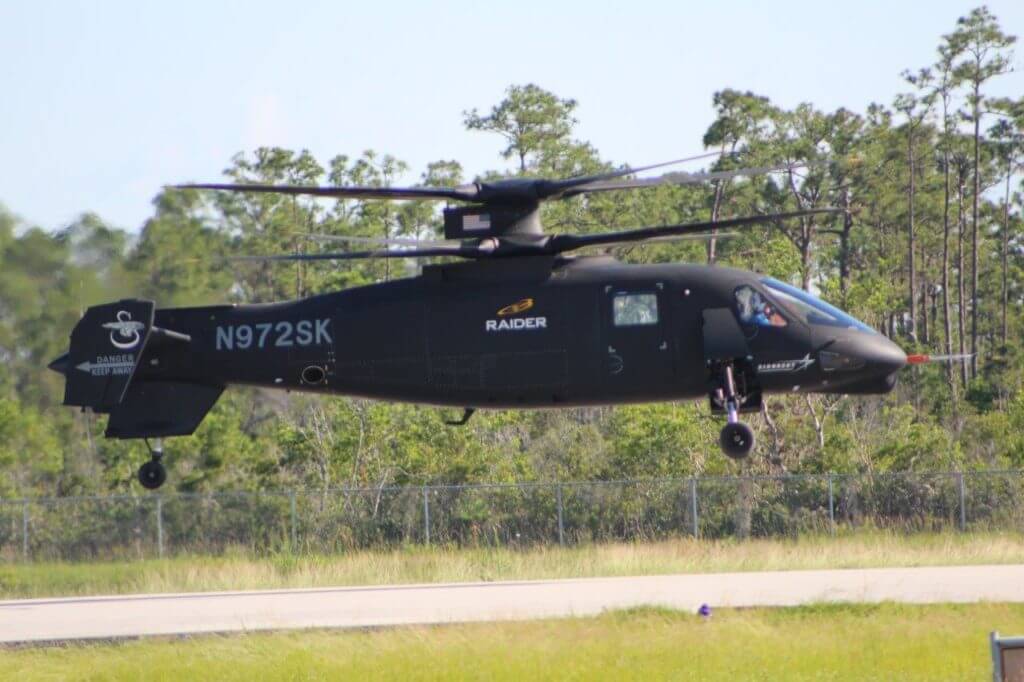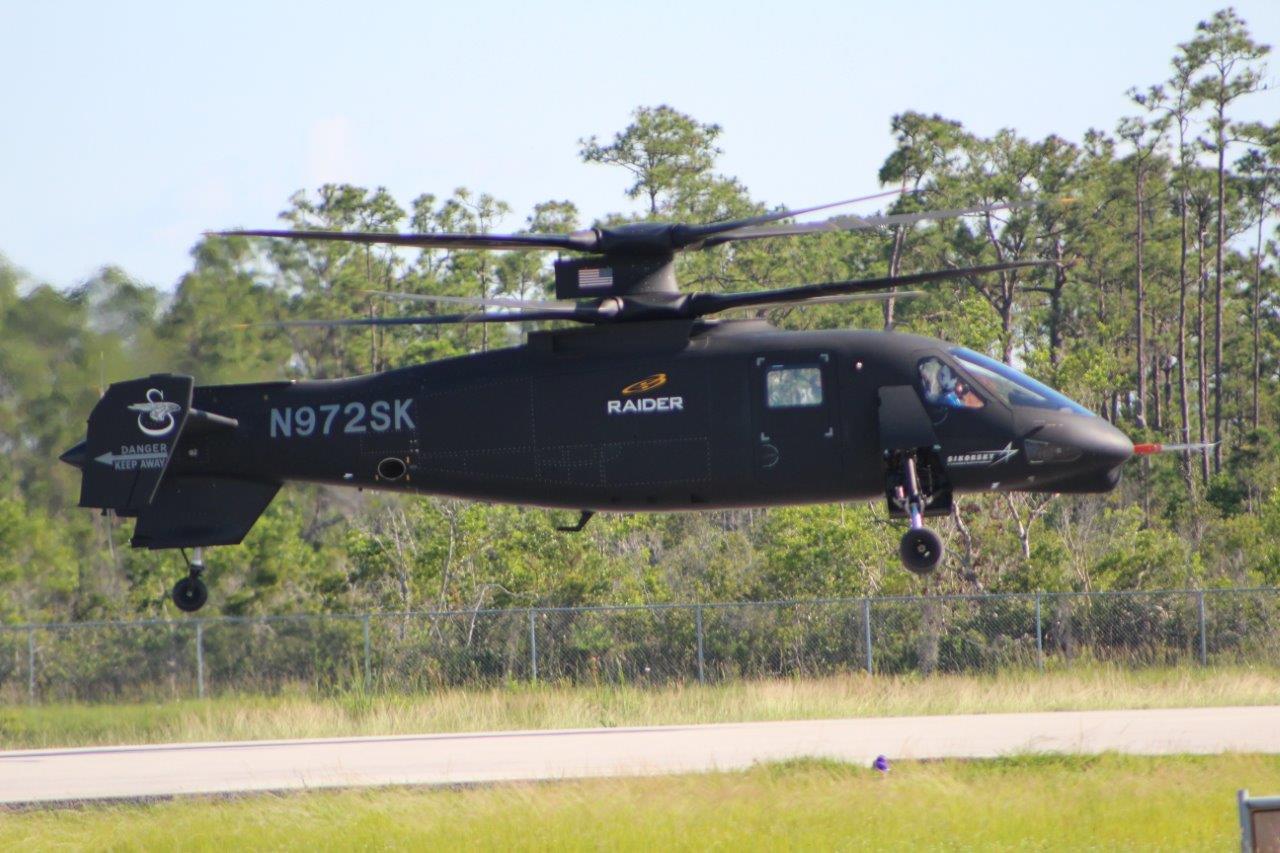The second Sikorsky S-97 Raider prototype has completed its first flight, marking the program’s return to flight testing following the first prototype’s hard landing in August 2017.

Sikorsky is using the Raider program to further mature technology developed in its X2 demonstrator — most notably its rigid coaxial main rotors and a variable-pitch pusher propeller (which enhance both the aircraft’s speed and its maneuverability) — for a possible Future Vertical Lift light application for the U.S. military.
The Raider is also serving as a “risk reducer” for the SB-1 Defiant — the larger high-speed rigid rotor coaxial rotorcraft Sikorsky is developing with Boeing for the U.S. Army’s Joint Multi-Role Technology Demonstrator program, in which it is competing against the Bell V-280 Valor.
The Raider’s first flight took place on May 22, 2015, but the program was grounded after the first prototype (Aircraft One) suffered a hard landing caused by issues with the flight control software as it performed a vertical takeoff during a flight test on Aug. 2, 2017. While the incident caused no significant injuries to either of the two flight crew members on board, the aircraft was sufficiently damaged to cause Sikorsky to choose to resume the flight test program with the second prototype (Aircraft Two) — which was not flight capable at the time.
Ground tests with Aircraft Two began earlier this year, with the first flight of the prototype taking place June 19 at the Sikorsky Development Flight Center in West Palm Beach, Florida. Sikorsky pilots Bill Fell and John Groth “flew the complete flight test card” the company said, and it “met all of the objectives” of the 90-minute flight.
“This is a significant milestone, which allows us to proceed with our full flight test program to demonstrate how Sikorsky’s X2 Technology is revolutionizing the future of vertical lift,” said Dan Spoor, Vice President, Sikorsky Future Vertical Lift. “We look forward to demonstrating to the U.S. military that high flight speed, and extraordinary maneuverability in the hover and low speed regimes, will dramatically change the way that military aviators fly and fight with helicopters.”
At the time of the hard landing, Sikorsky was in the process of expanding the Raider’s flight envelope, having recorded over 100 hours of ground runs and 20 hours of flight testing on the aircraft. The previous flight had taken the aircraft to 150 knots, with the accident flight scheduled to increase that speed to 180 knots. Sikorsky hoped the following flight would then explore the aircraft’s maximum speed, which it believes is over 220 knots.
According to Tim Malia, Sikorsky director, Future Vertical Lift Light, the first flight with the second prototype did not include high speed operation, but said the program team was “very pleased with the aircraft performance.”
Sikorsky will now be “systematically progressing” through the Raider’s flight test program, said Malia. “We will be generating the data to submit with our proposal [to the U.S. Army] to show that we have advanced this technology and it is proven compliant and ready to take the next steps. It is not a paper design.”










I love this architecture so much more than the tilt-rotor. It’s so much more practical with its small footprint suitable for getting into tight spaces. You’re not going to land a giant tilt-rotor on a street in urban warfare…its ridiculous. The tilt-rotor looks like something from a video game, but that’s the only reason I think its popular. The added maneuverability of this architecture with the ability to reverse thrust to rapidly slow, or nose down…I think people are realizing this is so much better for the role of a “helicopter” or FVL. The tiltrotor is a bit silly really.
You do realize that the footprint of a medium class version of the S-97 (aka SB-1) is actually a larger area footprint than the V-280 tiltrotor? Your eyes are fooling you because you don’t consider the size of the spinning rotor disc. The V-280 is actually almost exactly the same footprint as a UH-60.
Secondly, none of the previous or current ABC coaxial craft have ever demonstrated high maneuverability yet. Just look at Sikorsky’s own marketing video from last year! They show flight footage of the S-97 making gentle sweeping turns, then put up a title card stating “extreme maneuverability” and then show computer graphics!
The X2 never demonstrated the promised high G high speed maneuvers or hover maneuverability, nor did XH-59 before that. The V-280 just performed a demo flight that showed off its hover agility using much greater rotor flapping. An lest you forget, tiltrotors can hover at varying attitudes and accelerate/decelerate with level fuselage simply by tilting the nacelles. Its baffling that Sikorsky touts this as some kind of ABC advantage when any tiltrotor has always been capable f this by the very nature of tilting rotors!
Lastly, the elephant in the room is the vibration associated with all of the rigid rotor coaxial ships. In a word, its extreme. Once S-97 starts trying to push higher speeds, this will become a big issue, just like it did with X2.
One of the technologies associated with the S-97 program is vibration mitigation. They are claiming that they have significantly reduced vibration.
Logan the V280 has twice the footprint of a Black Hawk! (twice the rotor span)
the SB1 footprint is smaller than a Black Hawk! (slightly smaller rotor span)
The V-280 is wider than a UH-60 but not as long. In the specified 105m x 68m space with the same fore and aft and lateral spacing between aircraft, you can operate the same number of V-280s as Black Hawks, rotors turning.
Folded up, the V-280 is the size of a folded UH-1Y.
I for one, don’t trust the tiltotor design. The vortex ring issue, although they say it’s solved, is still problematic. The Raider is a better solution.